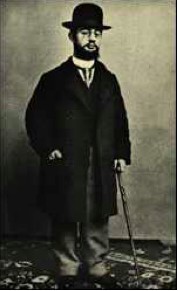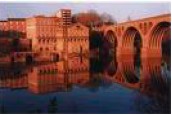The International Skeletal Dysplasia Society
8th Meeting, 2007, Albi, France
8th ISDS Meeting
2007 - July 19 to 22
Toulouse-Lautrec Museum, Albi, France
Organised by Valérie Cormier-Daire, Martine LeMerrer and Laurence Legeai-Mallet
See the Photo Gallery!
Abstract Book and List of Participants for download (PDF)


Scientific Program
8th Meeting
of the International Skeletal Dysplasia Society
ALBI, FRANCE
July 19-22, 2007
Gymnase de l'Athanor
Place de l'Amitié entre les Peuples
81 000 Albi, France
Thursday July 19
13h30. Opening.
15h-15H30
Welcome and Introduction
Pierre Maroteaux : Toulouse-Lautrec
15h30-16H45 NEW GENES
15h30. GDF5 and OA - of Human and of Mouse.
S. Ikegawa. Laboratory for Bone and Joint diseases, SNP Research Center. Riken, Japan
15h45. Mutations in PLEKHM1 involved in vesicular transport in osteoclasts cause osteopetrosis. B. Perdu, Department of Medical Genetics, University and Hospital of Antwerp, Antwerp, Belgium
16h00. Mutations in aggregan (AGC1) cause Dexter cattle chondrodysplasia.
R. Savarirayan, Murdoch Childrens Research Institute and University of Melbourne, Melbourne, Australia
16h15. AGC1 gene missense mutation associated with familial osteochondritis dissecans and early osteoarthritis. E.L. Stattin, Deparment of Medical Biosciences, Medical and Clinical genetics, Umea University, Umea, Sweden.
16h30. Autosomal recessive hypophosphatemia caused by a homozygous mutation in DMP1. O. Mäkitie, Hospital for Children and Adolescents, University of Helsinki, Helsinki, Finland
16h45-17h15 Break
17h15-18h30 Late Breaking News
17h15. Molecular pathology of Metaphyseal anadysplasia.
E. Lausch, Universitäts-Kinderklinik Mainz, Mainz, Germany
17h30. Molecular basis of Ghosal syndrome.
D. Genevieve, Department of Genetics and INSERM U781, Hôpital Necker-Enfants-Malades, Paris-France
Evening: Dinner Mairie d’Albi
***
Friday July 20
9h-10h15. Clinical delineation
9h00. Skeletal dysplasia in the Vienna collection.
P Beighton, Faculty of Health Sciences, University of Cape Town, Cape Town, South Africa
9h10. The skeletal phenotype of Schimke immuno-osseous dysplasia.
SF. Smithson , Deparment of Clinical Genetics, St Michael’s hospital, Bristol, UK
9h20. The clinical and radiological phenotype of Shprinzen-Goldberg syndrome: five new cases. C. Hall, Deparment of Radiology and Clinical Genetics, Great Ormond Street Hospital, London, UK
9h30. Defining disorders with Erlenmeyer Flask Bone Deformity.
M A. Faden, Medical Genetics Institute, Cedars-Sinai Medical Center, Los Angeles, USA
9H40. Towards a better delineation of Odontochondrodysplasia.
A. Superti-Furga, Ctr for Peds and Inst Hum Genet, University of Freiburg, Germany
9h50. Detection of microdeletions in limb malformation syndromes: a microdeletion in thrombocytopenia-absent radius (TAR) syndrome with a unique type of inheritance resembling autosomal recessive inheritance.
S. Mundlos, Max-Planck-Institut für molekulare Genetik, Berlin, Germany
10h00. Clinical and radiographic features of autosomal dominant brachyolmia.
D.H. Cohn, Cedars-Sinai Medical Center and David Geffen School of Medecine, UCLA, LA, USA
10h15-10h45 Break
10h45-12h00. Vertebral segmentation
10h45. Segmental patterning of the spine: from clocks to scoliosis.
O. Pourquié, Stowers Institute for Medical Research/Howard Hughes Medical Institute, Kansas City, Missouri, USA
11h45. A new classification system for congenital scoliosis and abnormal vertebral segmentation.
P. Turnpenny, Clinicals Genetics, Royal Devon & Exeter Hospital, Exeter, UK
12h00-12h45 Poster Session
12h45-14h15 Lunch (Parc de Rochegude)
14h15-16h30. Murine Models
14h15. Growth plate characterization in TSP35/Col9 Knock-out mice.
J.T. Hecht, University of Texas Health Science Center-Houston, Houston, TX, USA
14h30. Y367C mutation in mouse FGFR3 causes severe dwarfism by affecting both chondrogenesis and osteogenesis. S.Pannier, Department of Genetics, INSERM U781, Hôpital Necker-Enfants-Malades, Paris-France
14h45. Bone phenotype in a mouse model of Diastrophic Dysplasia.
B.Gualeni. Department of Biochemistry, University of Pavia, Italy
15h00.Reduced cell proliferation and increased apoptosis are significant
pathological mechanisms in murine models of mild pseudoachondroplasia and
multiple epiphyseal dysplasia resulting from mutations in MATN3 and COMP.
M. Briggs, Wellcome Trust Centre for Cell-Matrix Research, Faculty of Life Sciences, University of Manchester, UK
15h15 Multiple roles of neurofibromin 1 in skeletal development and growth.
S. Mundlos Max-Planck-Institut für molekulare Genetik, Berlin, Germany
15h30 Defects in Filamin B produce a variety of skeletal defects.
D. Krakow, Medical Genetics Institute, Cedars-Sinai Medical Center, UCLA, Los Angeles, USA
15h45 An inversion involving Sonic hedgehog (Shh) cis-regulatory enhancers is associated with malformations of the telencephalon and cranial sutures in the “Short digits” (Dsh) mouse. G. Schwabe, Institute of Medical Genetics, Berlin, Germany
16h00-16h30 break
16h30-17h30 "Unknowns" Session
17h30-18h30 ISDS DIAGNOSTIC COMPETITION
Evening: Dinner Chateau de Mauriac
***
Saturday July 21
8h30-10h30 Molecular Characterization
8h30. Genotype and phenotype of Stickler syndrome caused by mutation in the COL2A1 gene. K.Hoornaert, Center for Medical Genetics, Ghent University Hospital, Ghent, Belgium.
8h45. Genotype and phenotype correlation of POR mutations : phenotypic heterogeneity of Antley-Bixler syndrome. G. Nishimura, Department of Radiology, Tokyo Metropolitan Kiyose Children’s Hospital, Japan
9h00. SOX9, Campomelic and Acampomelic Dysplasia : A molecular and clinical update. G. Scherer, Institute of Human Genetics and Anthropology, University of Freiburg, Freiburg, Germany
9h15. An update on the spectrum of LEMD3 mutations in patients with osteopoikilosis, Buschke-Ollendorff syndrome and melorheostosis.
J. Hellemans, Center for Medical Genetics, Ghent University Hospital, Ghent, Belgium.
9h30. Genotype-Phenotype study in 240 MO patients.
L. Sangiorgi, Genetic Unit, Rizzzoli Orthopaedic Institute. Italy
9h45. The molecular genetics of Scheuermann disease.
M. Irving, Murdoch Children’s Research Institute, Melbourne, Australia
10h00. Molecular analysis of CUL7 in 3M syndrome.
C. Huber, Department of Genetics, INSERM U781, Hôpital Necker-Enfants-Malades, Paris-France
10h15. Czech dysplasia metatarsal type : another type II collagen disorder.
G. Mortier, Center for Medical Genetics, Ghent University Hospital, Ghent, Belgium.
10h30-11h00 Brea (Tour de France)
11h30-12h30 Poster Session 2
12h30-14h00 lunch (Parc de Rochegude)
14h00-16h15 Cellular-Molecular Characterization
14h00. Countering excessive FGFR3 signals in achondroplasia.
W Horton, Shriners Hospital/ OHSU, Portland, USA
14h30. Complexity of FGF signaling in chondrocytes. WR. Wilcox, Medical Genetics Institute, Cedars- Sinai Medical Center. Los Angeles, USA
14h45. Wisp1 is expressed during cartilage development. P. Kannu, Skeletal Biology and Disease, Murdoch Childrens Research Institute, Melbourne. Australia
15h00. New skeletal dysplasia candidate genes identified in a genome-scale analysis of cartilage-selective gene expression. D H Cohn, Medical Genetics Institute, Cedars- Sinai Medical Center, UCLA. LA, USA
15h15. Consequences of chondrodysplasia-associated point mutations in collagen II at the structural and cellular level. F Zaucke, Center for Biochemistry, Medical faculty, University of Cologne, Cologne. Germany.
15h30. Structural and functional characterisation of matrilin-3 and its implication for human chondrodysplasias. M. Fresquet, Wellcome Trust centre for Cell-Matrix Research, Faculty of Life Sciences, University of Manchester, Manchester, UK
15h45. High-definition imaging infrared micro-spectroscopy of cartilage in mice with normal and impaired diastrophic dysplasia sulfate transporter. E. L Mertz, Section on Physical Biochemistry, NICHD, National Institutes of Health, Bethesda , USA
16h00 Noggin mutations deregulate BMP signaling during limb devopment and lead to joint fusions and brachydactyly.
P. Seemann, Max-Planck-Institut für molekulare Genetik, Berlin, Germany.
16h15-16h40 Break
16h40-18h00 Management
16h40. Orthopedic management of chondrodysplasias.
G Finidori, Service d’orthopédie infantile, hôpital des Enfants Malades, Paris, France
17h00. Dynamic cervicomedullary cord compression and alterations in cerebrospinal fluid dynamics in children with achondroplasia.
D. Rimoin, Cedars-Sinai Medical Center. Los Angeles, CA, USA
17h15. The Restricted Growth Experience; Quality of Life and Barriers to Participation.
M J Wright, Institute of Human Genetics, Newcastle University, Newcastle upon Tyne, UK
17h30. Obstetrics and obstretical anesthesia issues in women with dwarfism.
J.E. Hoover-Fong, McKusick-Nathans Institute of Genetic Medecine, Johns Hopkins University, Baltimore USA
17h45. Open discussion- Guidelines : D.Rimoin
Cathedral (concert)
Toulouse Lautrec museum (visit and dinner)
***
Sunday July 22
9h-10h30 –Clinical Characterization
9h00. Angulated femurs and the skeletal dysplasias. Y Alanay. Clinical Genetics Unit, Department of Pediatrics, Faculty of Medecine, Hacettepe Unversity, Ankara, Turkey
9h10. Cerebro-osseous-digital syndrome-Clinical and radiological phenotype with histological findings.
CM Hall, Department of Radiology, Great Ormond Street Hospital for Children, London, UK
9h20. Delineation of a new syndrome with syn-/oligodactyly, urogenital malformations and anal atresia. S.Unger, Institute for Human Genetics, University of Freiburg, Germany.
9h30. Complex skeletal phenotype in a patient with a double insertional translocation between 7q and 10q and deletion of the TRPS1 gene on 8q24. R.Mendoza, Division of Clinical and Metabolic Genetics, Hospital for Sick Children, Toronto, Canada
9h40. Adams-Oliver syndrome: clinical variability in a four-generation family.
C. A. Bacino. Deparment of Molecular and Human Genetics, Baylor College of Medecine, Houston, USA
9h50. Foetal translucent bones associated with massive perivillous fibrin deposition in the placenta (gitterinfarct/ maternal floor infarct). P. G.J. Nikkels. Department of Pathology, University Medical Centre Utrecht. Utrecht, The Netherlands
10h00. Cervical spine defects in Menkes disease, a new finding potentially confused with evidence of child abuse. S. Hill, Warren Grant Magnuson, Clinical Center, Diagnostic Radiology, Bethesda, USA
10h10. Transforming the International Nosology of Constitutional disorders of Bone into a web accessible knowledge base. A. Zankl. Genetic Health Queensland, Royal Children’s hospital, Brisbane, Australia.
10h20-11h Break
11h-12h30 NEW PERSPECTIVES / Treatment
11h00. Growth hormone (GH) treatment of children with SHOX deficiency is effective and does not adversely affect body proportions: Two-year results of a randomized, controlled, multi-center trial . M. Rosilio Eli Lilly and Company, Suresnes, France
11h15. Nomenclature of OI syndromes
D Sillence Deparment of Genetics, The Children’s Hospital at Westmead Australia
11h30. Complications of Bisphosphonates
G Finidori Service d’orthopédie infantile, Hôpital des Enfants Malades, Paris, France
11h40. Penicillamine therapy results in symptomatic and radiological remission in diaphyseal dysplasia. D. Sillence. Deparment of Genetics, The Children’s Hospital at Westmead Australia
11h50. Perindropil reduces large artery stiffness and aortic root diameter in a randomised double blind study of patients with Marfan syndrome R. Savarirayan. Genetic Health Victoria, Murdoch Childrens Research Institute, Melbourne, Australia
12H00. Maroteaux –Lamy syndrome: E. Kakis
12h15 CONCLUSION
12h30 Lunch (hotel d’Orleans )
14 h30-15h00 End of the meeting
 Facebook
Facebook Twitter
Twitter LinkedIn
LinkedIn